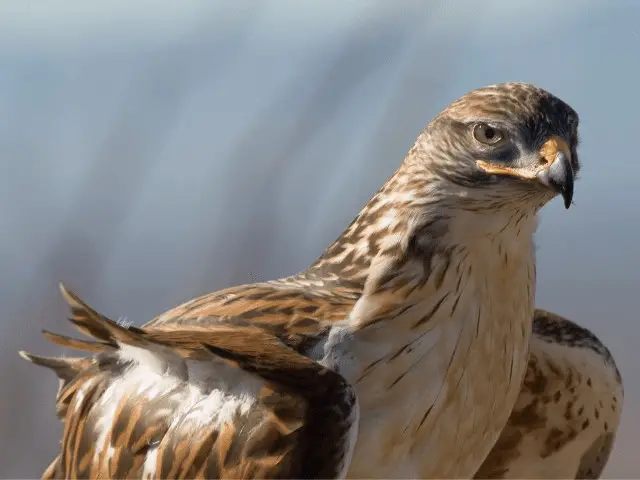There are about 270 species of hawks worldwide. In terms of vision, hawks have an eight-fold advantage over humans. They utilize such a remarkable vision for locating their prey even from a hundred feet away.
And, mind you...
Pennsylvania has different hawk species that you can either find year-round or only during certain seasons.
Maybe you are planning a trip to this state, or you're merely a bird lover who thinks that hawks are very captivating. If so, this article will provide you with more information about the different hawk species you can encounter in Pennsylvania.
Discovering The Hawks In Pennsylvania
Are you ever curious why some Pennsylvania hawks choose to live there? It is because the state has a diverse range of geographical zones. Mountains, lakes, and rivers surround this place. The wildlife has returned to this area, which is not surprising.
So, come on! Let us explore the phenomenal hawks in Pennsylvania:
1. Northern Harrier
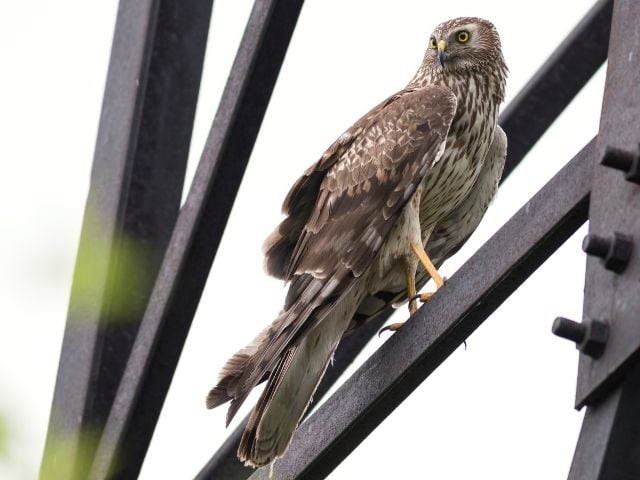
Length: 18.1-19.7 in
Weight: 10.6-26.5 oz
Wingspan: 40.2-46.5 in
Only a few Northern harriers are known to exist in North America. It has a recognizable white patch on its rump and an owl-like facial disk on its face.
These creatures have slender bodies with broad wings and an elongated, rounded tail. It’s easy to identify them at a distance because of the white patch on their lower back near the base of their tails.
Northern harriers hunt for prey by flying near the ground. They rely primarily on their hearing for prey acquisition, hunting reptiles and amphibians during the breeding season. A Northern harrier also loves eating a small bird, like a ruby-throated hummingbird, for instance.
2. Red-Tailed Hawk
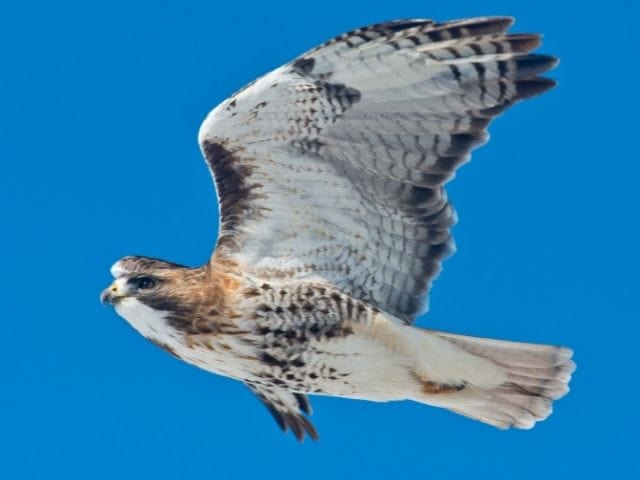
Length: 17.7-25.6 in
Weight: 24.3-51.5 oz
Wingspan: 44.9-52.4 in
Buteo jamaicensis is a red-tailed hawk's scientific name. This large bird has a broad body and outstretched wings with rounded edges. You might have greater chances of seeing them in open areas of grassland.
This hawk has a pale appearance throughout its lower regions, with darker streaks running across its belly in what looks like a black band. It has a rufous-colored tail and a dark brown top. You will notice how this hawk has light spots, scapulars, and a dark patch along the underwing's innermost part when in-flight.
Red-tailed hawks and bald eagles have a similar shape from afar, but their wings are shorter, and their heads are more diminutive. There is a noticeable difference between the bird's body and wings and a bald eagle, as red-tailed hawks' are paler by contrast.
On par with the golden eagle, red-tailed hawks have smaller, shorter wings and a more diminutive head than the golden eagle.
These hawks hunt from a high perch, then swoop down with their talons to catch prey. They hunt by plummeting above fields and transporting a tiny target to tree perches or consuming large-sized games on the ground.
They primarily consume small rodents, medium-sized mammals, and birds.
3. Sharp-Shinned Hawk

Length: 9.4-13.4 in
Weight: 31.-7.7 oz
Wingspan: 16.9-22.1 in
Forests and dense vegetation provide a habitat for the sharp-shinned hawk. This bird species is widespread throughout North and Central America; they have a remarkable ability to thrive in a wide range of habitats.
Short rounded wings and long, square-tipped tails help them manage through thick shrubs.
It hunts prey by flying quickly through the treetops or low over the ground, weaving around obstacles and catching victims off guard.
A small bird and some other mammals, including lizards and insects, are some of this hawk's prey during its hunting season. They resemble the cooper's hawk in appearance.
4. Cooper’s Hawk

Length: 14.6-17.7 in
Weight: 7.8-24.0 oz
Wingspan: 24.4-35.4 in
Cooper’s hawks are forest and woodland birds. You can encounter this kind of raptor in calm places like parks, farms, and sometimes along highways where there are trees.
A coopers hawk is similar in appearance to sharp-shinned hawks. Although it is more prominent, it has a slightly longer, rounded tail, thinner wings, and a huge head.
Cooper’s hawks mostly eat small mammals such as warbler, hummingbird, and more because they're safer to consume than medium-sized birds. They are similar that way with a chuck-will’s-widow species that even swallows a warbler whole.
Its common prey, according to studies, includes the following: European starlings, mourning doves, rock pigeons, various jays, Northern Flicker, quail, grouse, and chickens.
5. Northern Goshawk
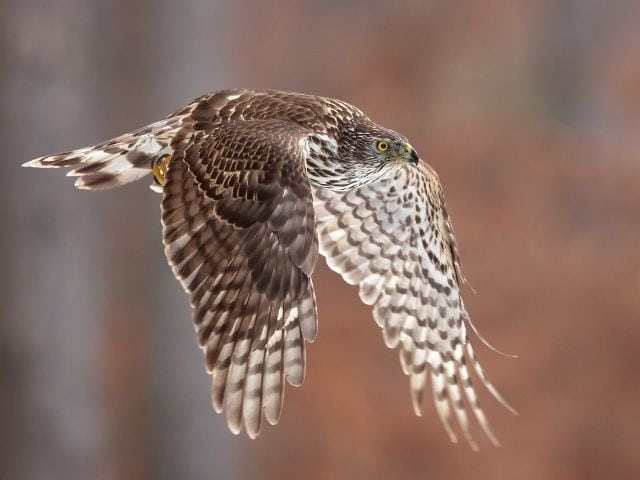
Length: 20.9-25.2 in
Weight: 22.3-48.1 oz
Wingspan: 40.5-46.1 in
In most of Pennsylvania, Northern Goshawk is found year-round, and this species is
This species looks like a cross between a coopers hawk and a sharp-shinned hawk. Because of its vast bulk, many people mistake it for a buteo.
In comparison to most accipiters, the Northern goshawk has a more excellent range of prey. Squirrels, snowshoe hares, jackrabbits, and cottontails are their primary prey. In exceptional instances, they will eat birds, reptiles, insects, and carrion.
6. Red-Shouldered Hawk
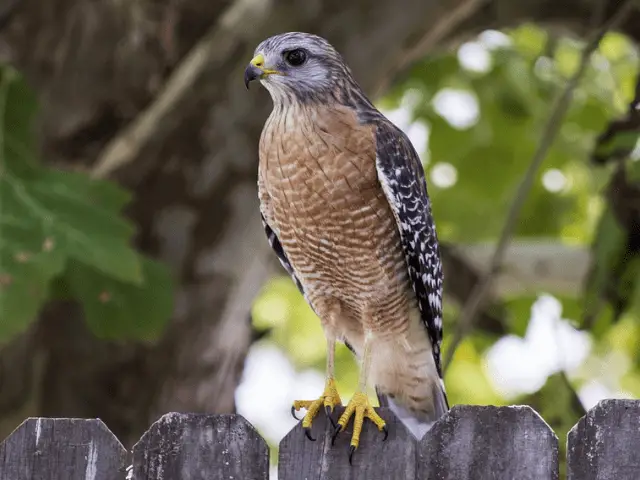
Length: 16.9-24.0 in
Weight: 17.1-27.3 oz
Wingspan: 37.0-43.7 in
Red-shouldered hawks or “Buteo lineatus” are buteos like red-tailed hawks, smaller-sized, and generally have longer tails. They also have thinner bodies than most other buteos.
Their plumage is a vibrant reddish-brown with dark brown patterning on the wings and striking black and white striping on the tails, and light spotting occurs along with the scapular.
They hunt from perches below the forest canopy or in the open, patiently waiting until they sight their prey below and rapidly moving downwards when it locates prey.
On occasion, red-shouldered hawks eat various animals, including reptiles and amphibians, as their principal prey and birds.
You can have a better view of this raptor and their other species at hawk watch sites like the Kittatinny Ridge or Hawk Mountain somewhere in Berks/Schuylkill county.
7. Broad-Winged Hawk
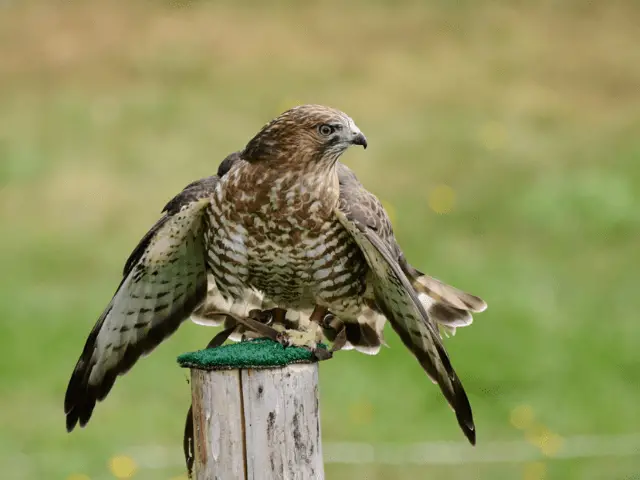
Length: 13.4-17.3 in
Weight: 9.3-19.8 oz
Wingspan: 31.9-39.4 in
You will most likely find broad-winged hawks breeding in the eastern United States' extensive deciduous and mixed forests. They prefer to nest near forest openings and bodies of water, away from human disturbance.
From perches, they quietly watch for prey, and if they see it, they dive rapidly downward to catch it with their claws. Small mammals, amphibians, and insects are the main foods of these raptors.
8. Rough-Legged Hawk
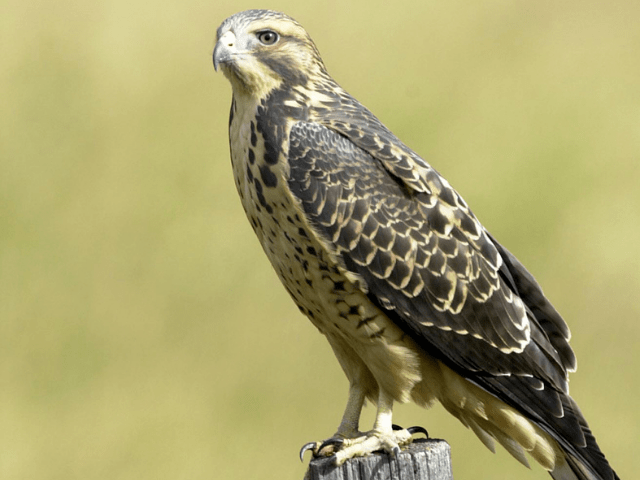
Length: 18.5-20.5 in
Weight: 25.2-49.4 oz
Wingspan: 52.0-54.3 in
A rough-legged hawk loves to dwell in open countries with hills during their breeding season or sometimes forest edges and treeless plains. Also known by its scientific name “buteo Lagopus.”
A rough-legged hawk is typically quiet in the winter but loud during the breeding season. Its kind is attractive because of the variation in plumage. Some would have theirs black, while the others look paler in contrast.
Unlike the raptors, you will not notice an owl’s presence because they are silent hunters. They are deafeningly quiet. It is their way of hunting their prey. Owls don't want to disturb their game by waking them up. Its calm demeanor makes them appear innocuous.
But behind those harmless looks, a great horned owl can crush the spines of its large prey effortlessly. The barred owl, on the other hand, quickly captures amphibians and little marine creatures.
Undoubtedly, a barn owl is constantly at the top of its game. It is exceptional in preying on small birds, like an American kestrel and ruby-throated hummingbird. The bird also hunts even an Eastern screech owl, consuming large-sized insects, rodents, mice, crayfish, and lizards.
Fun Fact: Wouldn't it be awesome if we divert our sights to another avian species -- crows! Get to know more about how they survive and where they thrive by reading our article.
Frequently Asked Questions
Why are hawks afraid of owls?
Without a doubt, everyone is aware that owls are nocturnal, sleeping in the morning and active at night. Some owls can grow to humongous sizes and soon outgrow hawks. As a result, at night, they eliminate hawks from their nest. Hawks prefer to avoid rather than combat an owl.
Which bird is more dominant -- the eagle or the hawk?
The majority of birders feel that eagles are more powerful than hawks, owing to their enormous stature. The eagle's strength comes from a combination of factors, including its powerful talons and solid legs.
Here are some things you didn't know about eagles:
Why is it against the law to possess a hawk feather?
As per the Migratory Bird Treaty Act of 1918, collecting some bird feathers, even those belonging to predatory birds, is unlawful because of a significant decline in their population. The almost century-old act safeguards migrating birds between the United States and Canada. Hunting was highly prevalent in the period since hats decorated with bird feathers were fashionable.
Hunting, taking, capturing, killing, or selling migrating raptors is prohibited under the treaty. The law applies to all parts of birds, including feathers, eggs, and nests.
Final Thoughts
In summary, we hope you find this article a handy guide to knowing more about the different Pennsylvania hawks you may encounter. Now you have a more profound understanding of these birds of prey, understanding their behavior and appearances better.
A large raptor is part of the migratory birds; their wings allow them to travel across the state quickly. They migrate to a warmer climate during the spring and fall.
Birdwatchers can find migrating hawks almost everywhere in North America. If you are interested, you can locate the hawk watch sites adjacent to the Atlantic and Pacific Ocean's shorelines and mountains, and of course, North America.

